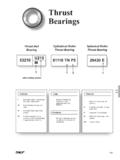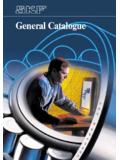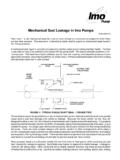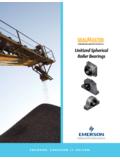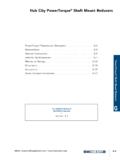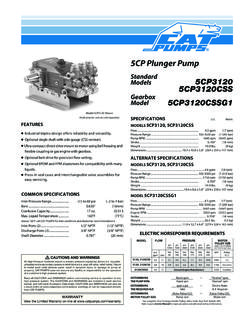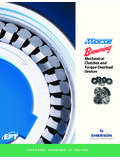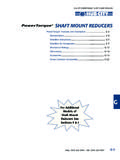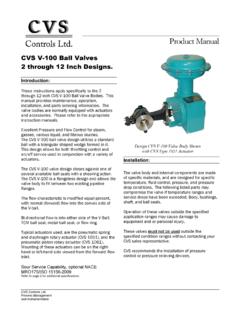Transcription of Industrial seal self study guide - SKF ležajevi iz prve ...
1 Industrial seal self study guideMaximizing radial shaft seal performance. 11 TABLE OF CONTENTSCC hhaapptteerr11 Introduction.. 2-4 BBaassiicc SSeeaall .. 55--99 Chapter 2 Review .. 10-11 SSeeaall DDeessiiggnn .. 1122--2288 Chapter 3 Review .. 29-31 SSeeaall .. 3322--4433 Chapter 4 Review .. 44-45 SSeeaall .. 4466--5500 Chapter 5 Review .. 5533--5577 Chapter 6 Review .. 58-59 SShhaaffttaanndd BBoorree .. 6600--6644 Chapter 7 Review .. 6677--7755 Chapter 8 Review .. 7788--8844 Chapter 9 Review .. 85-86 GGlloossssaarryy ooff SSeeaall .. 8877--9933 FFiinnaall .. 9944--11007722 CHAPTER 1 INTRODUCTIONThis book, produced for use by distributors and end-users, should prove of practical value to engineers, Industrial designers, maintenancesuperintendents and anyone who can benefit from a thorough understanding of will explain: What types of seals are available How to select the best seal for any given application How to improve performance with proper installation How to repair seal -worn shaft surfaces How to spot and correct seal problems economicallyHHooww ttoo UUssee tthhiiss SSttuuddyy GGuuiiddeeThis self - study guide is designed to increase performance chapter consists of a logical organization of material, technicaldiagrams and a short quiz to help you retain what you read the text portion of each chapter.
2 Make notes orunderline if you wish; this can help you remember what you ve material is designed for the individual s own learning pace. At theend of the program, you will have learned the same information andshould retain it as well as any other student. The chapter quizzes are an important phase of self - study learningsince they are intended to reinforce the material covered. The quizquestions are straightforward multiple choice and true false. There are no trick questions. Your answers can easily be checked by referring to the material presented in the each review in order before going on to the next chapter. If you are not sure of an answer to a question, check back in the chapter and review that portion you follow this procedure through all nine chapters, you should gain a thorough understanding of shaft will be able to test your knowledge through an overall FinalReview at the end of the book. This is a final check for the reader.
3 A Certificate of Merit to those who successfully pass the final reviewwith a minimum score of 85% will be issued. Instructions for obtaininga certificate are at the end of this HHiissttoorryy ooff tthhee SShhaaffttSSeeaallSKF Sealing Solutions invented and patented the first integrated, self -contained shaft seal in 1928 (fig. 1a). It was designed to holdgrease in automobile wheel hubs and help lubricate the wheel the mid 1930 s, SKF pioneered the development of custom formulating, compounding and molding of elastomers (synthetic rubber) to develop higher performance materials. This led to otherinnovations in manufacturing processes, new sealing techniques tohandle more demanding automotive and Industrial applications and the compounding and molding of various elastomer seals toimprove consistency and , SKF is the world s leading supplier of fluid sealing devices forthe truck, automotive, farm equipment, aircraft, heavy machineryand machine tool industries.
4 SKF also supplies seals for aerospacemissiles, earthmoving equipment, appliances, and a wide variety ofpumps, hydraulic systems, motors and company-wide commitment to quality earned SKF SealingSolutions significant certifications including TS16949 in December2002 and ISO 9001:2000 in May can supply more than 200 types of seals, over 3,000 stocksizes, and over 10,000 cataloged variations. That includes seals inboth inch and metric sizes, metal and rubber s in both bondedand assembled designs, with single or double lip elements and withor without springs or inner cases (fig. 1b).SKF sealing products fit shaft diameters from . 110 to over 180 .They fit metric shaft diameters from 3mm to over 4572mm. All are fashioned from an ever-growing spectrum of sealing elements and materials including LongLife fluoroelastomer lip materials.* That, plus ongoing development of new materials and processes, will enable SKF to meet tomorrow s expectations.
5 *LongLife is a registered trademark of SKFSKF invented the shaftseal in 1928 (fig. 1a).Over2 types of seals are nowavailable from SKF(fig. 1b).144 TThhee TToottaall BBeeaarriinngg aanndd SSeeaall SSeerrvviiccee CCoonncceeppttWhen bearings fail, they can bring equipment to an unscheduled halt. Every hour of downtime due to premature bearing failure can result incostly lost production, especially in capital intensive majority of bearings outlive the machinery or equipment in which they are installed. Of the bearings that do fail, only 1/3 fail due to normal fatigue. Over half of bearing failures result from lubrication or contamination problems both of which can be related to the sealingarrangement. Seals are vital to all bearing applications and are a criticalcomponent in an integrated systems approach to Trouble-Free SKF goal is to provide every bearing user with long, trouble-freeoperation. Our substantial investmentin research and development hasresulted in the production of bearings and seals of the highest , quality alone cannot guarantee trouble-free operation.
6 Other factors affect the life span of every bearing, including:OOppeerraattiinngg EEnnvviirroonnmmeennttMachinery must be kept in peak operating condition. The bearings shouldbe properly aligned and protected from extreme temperatures and properlysealed from moisture and contaminants. The seals must also retain thelubricant to assure a proper oil of the proper installation techniques and tools is required to ensure that the bearings and seals are not lubrication and maintenance schedules and monitoring bearingoperating conditions are also important in maximizing bearing OOppeerraattiioonn SKF is committed to the proper servicing and maintenance of thebearing/sealing arrangement. The Trouble-Free Operation Conceptminimizes the risk of bearing downtime and ensures that your bearingsachieve their full potential. A full line of products and services is availablefrom SKF to make installation and maintenance easy to Trouble-Free Operation Concept meets customer demands forlong bearing life and cost-effective (cont.)
7 55 SSeeaall FFuunnccttiioonnssWhenever a shaft rotates, it needs a bearing arrangement for smooth,effective operation. Wherever there s a bearing, you ll find a seal help-ing it to reach its maximum service life and reliability. In simplest termsa shaft seal is a barrier has four functions: Retain lubricants and/or liquids Exclude dirt/contaminants Separate fluids Confine pressureWhen a seal performs these functions properly, it protects the bearingfrom harmful contaminants while retaining a clean lubricant supply,resulting in lengthened bearing service life and reliability. The bearingsdo their job better, cleanliness of production and process materials ismaintained, lubricant is saved and machinery downtime is reduced. An integrated bearing/ seal system approach is the best way to achievetrouble-free operation (fig. 2a).Seals handle a broad range of media, from light oil to heavy grease tohot turbine gases.
8 Electric motors and gear reduction units are someof the more common applications, however there are extremes requir-ing very special example, seals protect the high speed turbine pump in a rocketthat accelerates from 0 to 12,000 rpm in one-fourth of a types of seals protect the drive unit in a track type earth mover,operating at only 15 to 30 SSeeaallssThe function of static seals is to create barriers between relatively non-moving surfaces. Typical static applications of seals are valve-cover gaskets, cylinder covers, packings of many kinds, and o-rings used in stationary situations. The gasket lining a refrigeratordoor used to seal the inside chilled air from the outside ambienttemperature is a classic static seal application. Static simply meansthat no relative motion takes place in the performance of the sealingfunction. The sealing devices for such applications are often tailoredfrom o-rings. Typical sectional views of static seal applications areshown in figure takes place as lube isretained and outside contaminantsare excluded (fig.)
9 2a).Sectional views of typical static or non-moving sealapplications(fig. 2b).2 Chapter 2 Basic seal Types At the interface point, a thin film of lubricant separates sealing surfaces(fig. 2e).66 BASIC seal TYPES (cont.)DDyynnaammiicc RRaaddiiaall SSeeaallssA dynamic radial seal creates a barrier or interface between surfaces in relative motion. For radial lip type seals, the interface is where theseal touches the shaft . Sealing is accomplished by two surfaces makingcontact radially, one usually stationary while the other example of a radial seal is shown in figure 2c. As the shaft rotates in a stationary housing, a CRW1 seal both retains lubricant andexcludes contaminants. Typical radial seal applications include gearboxes, drives, motors, pumps and speed MMeecchhaanniiccaall SSeeaallssAxial mechanical seals are face type seals which create an axial seal interface between matched, radially mounted components.
10 Inoperation, one contact face is usually stationary in the housing whilethe other moves with the shaft . Sealing pressure is applied in the axial direction through a spring mechanism. The spring force keeps the surfaces mechanical seals are generally used where pressure and/orsurface speeds exceed the capabilities of radial shaft seals. Typicalapplications are water pumps and most types of pumps used in chemical processing plants or refineries. Figure 2d is a view of such an types of axial seals are non-mechanical ones, such as IInntteerrffaaccee Interface is the point of contact between sealing surfaces (fig. 2e). Butthey do not really contact at that point, they are separated by a filmof lubricant as thin as in. a hundred thousandths of an metrics, that is lubricant film prevents rapid wear of the seal lip and/or the shaftsurface. But interface tolerances must be precise to keep the lubricantfrom leaking.
